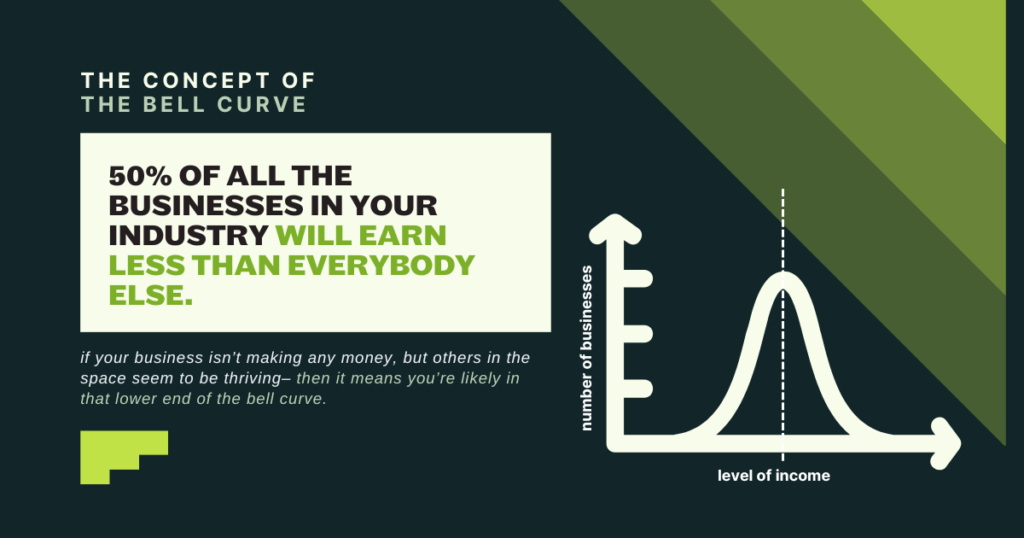Sometimes you might be wondering “why is my business not making any money?” despite all the blood, sweat, and tears you’ve been putting in.
If you’ve been running your business for any time, you may have found yourself in a situation where you’re not making any money. It can be frustrating, and you may be wondering what on earth you need to do to get your business back on track.
Businesses fail for many reasons, but the most common is that the business does not have any clientele– you’re not closing enough deals, or perhaps you’re not attracting enough customers to begin with.
And then again, you might be making money, and things are going reasonably well, but you slowly realize that you’re not growing as quickly as you’d like. Or even worse, you’re putting in all the hard work but still losing money. Worst of all: you don’t even know why.
So understandably, that lack of understanding or getting things back in control can be frustrating.
In this article, we’ll help you understand why your business might not be making money. More importantly, we’ll show you exactly what you can do about it.
Having spoken with thousands of business owners over the last decade – there’s a dramatic difference between top performers and everyone else.
Check out our related piece, “What Are The Benefits of Having a Business Coach (By Your Side)?”
Understand That Businesses Have a Bell Curve Too
The average business owner is a hard worker, who works long hours and takes pride in their work. However, hard work is not enough to ensure success. The life of a business is cyclical, and every business owner must be aware of the ups and downs in their business.
Of course, every business owner wants to be at the top of their game. But the reality is that not all of them get there.
Like in any other field, the business space also has its own bell curve. Whether you’re a plumber, a dentist, a web designer, or even how many years you’ve been in the business doesn’t matter.
This concept of a bell curve means 50% of all the businesses in your industry will earn less than everybody else.
And so if your business isn’t making any money, but others in the space seem to be thriving– then it means you’re likely in that lower end of the bell curve.
So how do we now turn things around so that you’re doing better than everyone else instead?
If you’d like more insights on estimating what your business is worth, check out this related piece on how to value a business.
The Top Performers in Your Space Are Doing Something You’re Not
Now, having spoken with thousands of business owners over the last decade, we’ve observed a dramatic difference between the top performers and everybody else here at Predictable Profits.
These little differences determine which side of the bell curve you’re likely going to be on.
Let’s start figuring things out by answering a few simple questions:
- Do you monitor your KPIs at a minimum once a week?
- Do you have a strong and compelling unique advantage in the market?
- Can you charge premium prices and still have clients lining up to do business with you?
- Are you constantly testing what’s working and what’s not working?
- Have you built a culture of innovation so that you’re asking yourself a question like “what needs to happen for us to deliver an even greater experience and a greater result for our clients?”
- Do you have a documented system in place for re-engaging lost clients as well as reselling existing clients?
So think about your answers.
Simply put: the more you answered ‘no’ to any of those questions, the greater the probability you are to be on the side of that bell curve that earns less than half of your industry.
Growing a business starts by understanding the basics and then building on this knowledge. Read more about next-level growth strategies in this related feature: “The Predictable Profits Guide to Growing Your Business.”
The Six (Most Likely) Reasons Why Your Business Isn’t Doing So Well
Let’s have a look at the most common issues we’ve noticed with businesses when it comes to performance. Knowing why you’re lagging behind (at least compared to others within your space) also allows the opportunity for you to do something about it and turn things around.
1. You’re Not Monitoring Your KPIs
There’s this old saying: ‘what gets measured, gets managed.’ And of course, what gets managed gets improved.
Probably the most important thing you can do right now to get your business back on track (and keep it on track) is to monitor your KPIs– your key performance indicators.
Among all the thousands of business owners we’ve talked to here at Predictable Profits, here’s an interesting observation: the highest earners (among our clientele) were the ones that not only knew their KPIs but also tracked them daily.
What sort of KPIs are we talking about?
At a minimum, you should know your sales revenue, lead flow, and customer lifetime value. Your most important KPIs are what tell you when you’re on track. Trends in your KPI figures also signal when something needs your attention.
Tracking your KPIs accomplishes a few things:
- It removes the guesswork so that you know exactly what’s working and what’s not.
- You’re identifying the areas in your business that need the most attention for improvement.
- It allows you to immediately identify opportunities to scale
Look at it this way: if you don’t track daily, you’ll have no idea where the problems are in your business. Well, at least until they get bigger.
Remember: tracking daily allows you to be proactive and to deal with things immediately, rather than be reactive.
2. You Don’t Have a Compelling Enough Unique Advantage
As business owners, we’ve already established that it’s increasingly difficult to just cut through the noise and stand out.
Remember: the average buyer compares you against 12 to 14 of your competitors before they make a purchase decision.
And if you’re not clearly different and illustrate a distinct advantage over your competitors, your buyers aren’t going to know why they should choose you over your competitors.
This is why having a clear and compelling unique advantage point is so important.
This unique advantage allows you to position your business in a way that provides a superior product or service over all your competitors.
Marketing expert Seth Godin once famously said, “You can either fit in or stand out. Not both.”
So how can you figure out your unique advantage point? Ask yourself these questions:
- What is the ultimate advantage, benefit, or result that your prospects want to achieve when they start working with you?
- How will your product or service make your clients live better in a way not currently offered to them by your competitors?
- What makes your business better than your competition?
You can create an answer to those questions that instantly separates you from the competition.
And once you’ve figured out your unique advantage, this becomes the nucleus of your entire marketing message.
Use it to get people to stop in their tracks, pay attention, and then identify why you’re different and the advantages you provide over your competition.
Read more about the concept of The Unique Advantage Point (and how you should be using it to grow your business).
3. You’re Hesitant to Charge More
Now for some business owners, charging customers higher prices triggers the fear of losing clients. After all, they could simply go to a competitor that offers the same product or service for less, right?
However, history has proven that low-cost competitors don’t survive in the long run.
Whether you’re B2B or B2C, if having a low price is the ONLY reason why people chose to do business with you – the moment someone is cheaper, they’ll drop you like a hot potato!
This is why it is imperative that you give your customers a better reason to shop with you other than price. You must have a strategy in place to charge premium pricing and still have clients lining up to do business with you.
So how exactly can you accomplish this?
Take note that people always have money for the things that are important to them. They will pay more for exceptional experiences: convenience, speed, security, time, image, and so on.
So offer an element to your product or service that adds more value. So much so that they’re willing to pay more for it.
Ask yourself: What else can I do for my clients that will give them a greater value, benefit, and experience to help them achieve the ultimate result that they are after?
Figure out the answer to that question, and you’ve just escaped the commodity trap. You can now charge your customers a premium price while still being the go-to brand in your space.
4. You Don’t Know What’s Working and What Isn’t
Are you constantly testing what’s working and what’s not working?
When it comes to business, three core principles separate the top performers from the rest.
And they are testing, testing, and testing.
Even the most brilliant business minds in the world can’t predict how their market will react until they do some testing first.
This is particularly true when it comes to marketing and advertising, say running some Facebook ads, introducing a special offer, or sending out a series of email newsletters.
The key to successful testing is getting all the variables and testing them one at a time. Ensure you’re adding tracking features like coupon codes, unique URLs, special call-in numbers, and whatever you need.
The tangible results of your tests will be your guiding light – they tell you what to pursue and how to go about pursuing it.
According to our CEO and Founder, Charles Gaudet, “knowing the difference between what’s working and what isn’t… well, it’s about the most powerful bit of information you can have.”
5. You Don’t Feel The Need to Change Things Up
Innovation should always be at the core of your company culture.
In essence, innovation answers the question, “how can we make things better?” Depending on the situation, however, this drive for innovation can look for very specific answers:
“What needs to happen in order for us to deliver an even greater experience and a greater result for our clients?”
“What else can I do for my clients that will give them a greater value, benefit, and experience to help them achieve the ultimate result that they are after?”
“How can we better position our product or service that solves our clients’ pain points in a way that’s not currently offered to them by our competitors?
With innovation, you can keep your company on the cutting edge while leading your competition.
Don’t be afraid to be different– use your creativity and desire to solve your customer’s problems to develop something new.
Or at least a fresh perspective or spin to make your customers want to do business with you more than anyone else.
We discuss innovation in The OSI Method™, a blueprint we’ve developed to help businesses generate consistent, predictable, and rapid results more efficiently.
6. You Don’t Have the Right Business Systems in Place
Lastly, but certainly not least, you must have baseline business processes in place to help you control the chaos and inefficiency within your business.
Oftentimes, many aspects of your sales, or even your marketing or operations, are left to chance. So having the right business systems in place could lead to powerful time management, boosted productivity, and even increased profits.
For example:
- You could have a documented system in place for re-engaging lost clients and reselling existing ones.
- You might have a sales playbook to guide your sales team step-by-step
- You could institute a more systematic way of following up on your leads using marketing automation tools
- Use workflow management to control everyday tasks for consistency and efficiency.
Dr. W. Edwards Deming, the man responsible for revolutionizing Japan’s business industry after World War II, is often quoted saying: “Uncontrolled variation is the enemy of quality.”
Remember: consistency is the key to a successful company. There’s a reason why businesses like McDonald’s, The Ritz-Carlton, Starbucks, and Apple have become so successful.
You can take a cue from these market leaders, and start putting key business systems in place.
A Final Word on What You Should Be Doing When Your Business is Not Making Money
By taking a good hard look at your situation (using the questions we’ve shared above), you now have a list of relatively easy action items you can do when things aren’t going so well for your business.
With our earlier concept of the bell curve in mind and the questions we’ve followed up with, It’s now all relatively easy to swing the odds in your favor.
Observe the big players in your industry and take a cue from them. Taking active steps to do the things top performers in your industry have been known to do will allow you to get more out of your business.
Be part of our ever-growing community of seven- and eight-figure business owners:
- Check us out on the Predictable Profits YouTube channel.
- Connect with us on Linkedin.
- Join other entrepreneurs (like yourself) on our Facebook page.
- And if you haven’t already, sign up for our daily business coaching video series (by entering your email address below).








